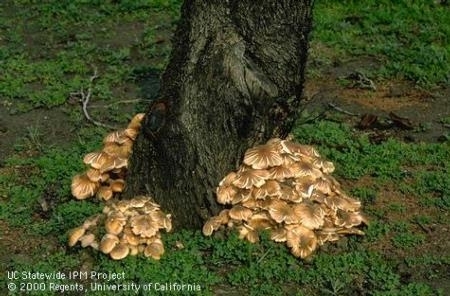By Brent McGhie, Butte County Master Gardener, October 3, 2014

Oak root fungus attacks the sapwood just beneath the bark of the lower trunk and roots of infected plants. This disrupts the flow of water and nutrients in the plant. When this occurs, the first above ground symptoms to be noticed are stunted shoots, discolored leaves and excessive leaf drop. There may also be cankers and gumming of the trunk just below or at ground level. When the bark of infected roots or the trunk beneath the soil line is peeled away, cream-colored fungal threads (mycelia) are present. These mycelia have a distinct mushroom-like odor. They may appear on the surface of herbaceous plants as well. Honey-colored Armillariamushrooms typically emerge anytime between Thanksgiving and Valentine's Day and, when present, are always found in clusters around infected plants.
Armillaria is always associated with wood; it does not live independently in the soil. Armillaria spreads from plant to plant when a root from an uninfected plant grows into the fungal mycelium, or when specialized fungal structures called rhizomorphs bridge a short distance (less than one inch) between a diseased root and an adjacent healthy plant's root. Once Armillaria comes in contact with a living root, it dissolves the bark and decays the wood. Although the interaction of environmental factors is not completely understood, it appears that high soil moisture, high concentrations of Armillaria, and close plant spacing are key factors that favor the spread of oak root fungus.
There are no fungicides available that kill Armillaria. The only effective controls are planting resistant plant species and employing other appropriate cultural practices such as avoiding over-irrigation and avoiding moving infected root pieces to new uninfected locations. Drying Armillaria kills it. Reports state that oak root fungus growth has been slowed or stopped by removing the soil from around the base of an infected plant and allowing the area to dry completely. If an area is suspected of being infected with Armillaria, prepare the soil by removing roots and wood debris and air-drying the soil before planting. Then provide the new plants with adequate drainage and appropriate irrigation. Do not over-water.